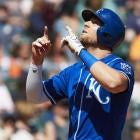Six years ago the Kansas City Royals selected third baseman Hunter Dozier with the eighth overall pick in the 2013 draft, and part of the plan was saving bonus pool money. Injury and signability concerns had lefty Sean Manaea poised to slip, and Kansas City was prepared to pay him. The Royals drafted Dozier higher than projected, paid him a $2.2 million bonus that was under his $3.1 million slot value, and gave the savings to Manaea, who they took with the 34th pick.
The decision paid off in 2015. Manaea headlined the trade package that went to the Athletics for eventual World Series MVP Ben Zobrist, and that alone justifies the draft strategy. Now though, Dozier is finally starting to establish himself with the Royals, and he's doing it in a big way. The 27-year-old has been one of the best hitters in baseball so far this season.
Dozier made his big league debut as a September call-up in 2016 and he spent most of 2017 and part of 2018 underwhelming in Triple-A. The Royals gave him a 102-game look last year and he authored a .229/.278/.395 batting line with 11 homers in 388 plate appearances. For a 26-year-old rookie who'd spent parts of three seasons in Triple-A, that ain't good.
Despite the poor numbers, Dozier did show some encouraging skills during his 2018 stint with the Royals. For starters, he's sneaky fast for a big man (6-foot-4 and 220 lbs.) -- Statcast measured Dozier's sprint speed in the 86th percentile last year -- and the Royals love fast. Fast is their thing. Also, Dozier had better than average contact quality:
- Exit velocity: 89.5 mph (66th percentile)
- Hard-hit rate: 40.2 percent (65th percentile)
That's something. You can't fake hitting the ball hard. You can fake hitting .300 for a month but you can't fake exit velocity. This season, Dozier has improved his contact quality -- he's in the 91st percentile in exit velocity this year -- and it's because he's improved his plate discipline tremendously. Few players have improved their plate discipline as much as Dozier this year.
So far this season Dozier has swung at 23.8 percent of the pitches he's seen outside the strike zone, a top 30 mark in baseball and much better than the 32.1 percent league average. Only one player has improved on last year's chase rate as much as Dozier:
| 2018 Chase Rate | 2019 Chase Rate | Improvement | |
|---|---|---|---|
35.2% | 24.4% | 10.8% | |
Hunter Dozier, Royals | 34.5% | 23.8% | 10.6% |
35.6% | 25.4% | 10.1% | |
38.4% | 28.8% | 9.6% | |
Freddie Freeman, Braves | 34.7% | 26.1% | 8.7% |
The goal of plate discipline is not drawing walks. Walks are a byproduct. First and foremost, hitters work the count to get something to hit. They want a hittable pitch out over the plate, and they want to punish it.
Dozier, after making contact on a slightly below average 88.2 percent of the pitches he saw in the strike zone last year, is up to a 94.6 percent contact rate in the strike zone this year. It's the third best zone contact rate in baseball this season and the fourth best year-to-year improvement.
- David Fletcher, Angels: 99.2 percent zone contact rate
- Michael Brantley, Astros: 96.1 percent
- Hunter Dozier, Royals: 94.7 percent
- Mookie Betts, Red Sox: 94.5 percent
- Mike Trout, Angels: 94.1 percent
| 2018 Zone Contact Rate | 2019 Zone Contact Rate | Improvement | |
|---|---|---|---|
78.8% | 88.5% | 9.7% | |
82.6% | 91.5% | 8.9% | |
Martin Maldonado, Royals | 84.7% | 93.4% | 8.7% |
Hunter Dozier, Royals | 87.9% | 94.7% | 6.7% |
78.6% | 83.7% | 5.1% |
That's a lot of words and tables and numbers to say Dozier has an elite chase rate, an elite contact rate on pitches in the strike zone, and elite exit velocity. That is an excellent combination. That's how you put up a .318/.413/.621 batting line despite playing your home games in spacious Kauffman Stadium. The process behind Dozier's results has been sound.
Here's what Dozier told Sam Mellinger of the Kansas City Star about his breakout season recently:
"Something I'm trying to be a little better at is really only swinging at good pitches," Dozier said.
...
"I think it's just mentally having a better approach," Dozier said. "Trusting yourself. For me, it starts with the hands. Really just competing in the box and not just thinking it's all about mechanics. Really just trying to see it and hit it, honestly."
Not the most revealing answer, but "how did you improve your approach?" isn't exactly easy to answer. It usually comes down to experience and the player gaining a better understanding of who he is as a hitter, not some nugget from a coach or a revelation during a video session. "Really just trying to see it and hit it, honestly," sums it up pretty well.
Chances are Dozier is not truly this good. He's outhitting his Statcast expected batting average (.296) and slugging percentage (.547) by quite a bit -- Statcast's expected outcomes are based on exit velocity and launch angle and all that -- plus there are very few players in baseball who are true talent .300/.400/.600 guys. I don't buy Dozier as one. Not yet. Not after 150-something plate appearances in 2019.
That all said, Dozier's expected batting average and slugging percentage are very good, and the improvement in his plate discipline is legitimate. This is a talented player who has changed as a hitter, and is reaping the rewards. The Dozier-Manaea draft move in 2013 has already been a smashing success thanks to the Zobrist trade. Dozier emerging as an offensive force and the third baseman of the future is icing on the cake for Kansas City.
























